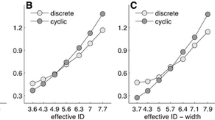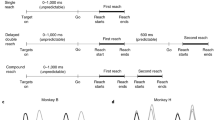Abstract
This work investigated whether fundamental differences emerged between segments of complex movement sequences performed at different instructed speeds. To this end, we tested 5 novices and 1 karate expert as they performed beginner’s martial arts routines. We found that if one blindly took these segments and separated them according to the variability of trajectory parameters, one could unambiguously group two classes of movements between the same two space regions: one type that remained quite conserved despite speed changes and another type that changed with speed level. These groups corresponded to functionally different movements (strike segments explicitly directed to a set of goals and spontaneously retracting segments supplementing the goals). The curvature of the goal-directed segments remained quite conserved despite speed changes, yet the supplemental movements spanned families of trajectories with different curvature according to the speed. Likewise, the values of the hand’s peak velocity across trials were more variable in supplemental segments, and for each participant, there were different statistical signatures of variability between the two movement classes. This dichotomy between coexisting movement classes of our natural actions calls for a theoretical characterization. The present experimental results strongly suggest that two separate sets of principles may govern these movement classes in complex natural behaviors, since under different dynamics the hand did not describe a unique family of trajectories between the same two points in the 3D space.






Similar content being viewed by others
References
Abend W, Bizzi E, Morasso P (1982) Human arm trajectory formation. Brain 105(Pt 2):331–348
Atkeson CG, Hollerbach JM (1985) Kinematic features of unrestrained vertical arm movements. J Neurosci 5(9):2318–2330
Bernstein NA (1967) The co-ordination and regulation of movements, 1st English edn. Pergamon Press, Oxford
Berthier NE, Keen R (2006) Development of reaching in infancy. Exp Brain Res 169(4):507–518. doi:10.1007/s00221-005-0169-9
Butterworth S (1930) On the theory of filter amplifiers. Exp Wirel Wirel Eng 7:536–541
Conditt MA, Mussa-Ivaldi FA (1999) Central representation of time during motor learning. Proc Natl Acad Sci USA 96(20):11625–11630
Duda O, Hart P, Stork D (2001) Pattern classification, 2nd edn. Wiley, New York
Flanders M (2011) What is the biological basis of sensorimotor integration? Biol Cybern 104(1–2):1–8. doi:10.1007/s00422-011-0419-9
Gargner JM, Karmel BZ, Magnano CL, Norton KI, Brown EG (1990) Neurobehavioral indicators of early brain insult in high-risk neonates. Dev Psychol 26(4):563–575
Gibson JJ (1966) The senses considered as perceptual systems. Houghton Mifflin, Boston
Guigon E, Baraduc P, Desmurget M (2007) Computational motor control: redundancy and invariance. J Neurophysiol 97(1):331–347. doi:10.1152/jn.00290.2006
Isenhower RW, Metaxas DN, Jose JV, Torres EB (2011a) Movement variability as an objective classification tool for autism spectrum disorders. J Neurosci (submitted)
Isenhower RW, Metaxas DN, Torres EB (2011b) Physical metrics of fluency training and task complexity in the natural movements of children with ASD gauge learning in the classroom environment. Paper presented at the Society for Neuroscience (SFN), Washington
Izenman AJ (1991) Recent developments in nonparametric density estimation. J Am Stat Assoc 86(413):205–224
Jose JV, Isenhower RW, Torres EB (2011) Statistics of motor variability used as a classification tool for spectral disorders: application to Autism and Parkinson’s disease. Paper presented at the Society for Neuroscience (SFN), Washington
Karmel BZ, Gardner JM (2005) Neurobehavioral assessment in the neonatal period—the impact of Ferenc Katona. Ideggyogy Sz 58(9–10):315–323
Karmel BZ, Gardner JM, Meade LS, Cohen IL, London E, Flory MJ, Lennon EM, Miroshnichenko I, Rabinowitz S, Parab S, Barone A, Harin A (2010) Early medical and behavioral characteristics of NICU infants later classified with ASD. Pediatrics 126(3):457–467. doi:10.1542/peds.2009-2680
Kelso JAS (1995) Dynamic patterns: the self-organization of brain and behavior. MIT Press, Cambridge
Kelso JAS, Engstrøm DA (2006) The complementary nature. MIT Press, Cambridge
Konczak J, Dichgans J (1997) The development toward stereotypic arm kinematics during reaching in the first 3 years of life. Exp Brain Res 117(2):346–354
Konczak J, Thelen E (1994) The dynamics of goal-directed reaching: a comparison of adult and infant movement patterns. In: Van Rossum JH, Laszlo JL (eds) Motor development: aspects of normal and delayed development. VU University Press, Amsterdam, pp 25–40
Kugler PN, Turvey MT (1987) Information, natural laws, and self-assembly of rhythmic movement. L. Erlbaum Associates, Hillsdale
Lacquaniti F, Soechting JF, Terzuolo CA (1982) Some factors pertinent to the organization and control of arm movements. Brain Res 252(2):394–397
Limpert E, Stahel WA, Abbt M (2001) Log-normal distributions across the sciences: keys and clues. Bioscience 51(5):341–352
Mardia KV, Kent JT, Bibby JM (1979) Multivariate analysis. Probability and mathematical statistics. Academic Press, New York
Marey E-J (1874) Animal mechanism; a treatise on terrestrial and aerial locomotion. International scientific series (London, England), vol 11, 2nd edn. Henry S. King & Co., London
Marey ÉJ, Pritchard E (1895) Movement. D. Appleton and company, New York
Morasso P (1983) Three dimensional arm trajectories. Biol Cybern 48(3):187–194
Nishikawa KC, Murray ST, Flanders M (1999) Do arm postures vary with the speed of reaching? J Neurophysiol 81(5):2582–2586
Quian Quiroga R, Snyder LH, Batista AP, Cui H, Andersen RA (2006) Movement intention is better predicted than attention in the posterior parietal cortex. J Neurosci 26(13):3615–3620. doi:10.1523/JNEUROSCI.3468-05.2006
Redgrave P, Rodriguez M, Smith Y, Rodriguez-Oroz MC, Lehericy S, Bergman H, Agid Y, DeLong MR, Obeso JA (2010) Goal-directed and habitual control in the basal ganglia: implications for Parkinson’s disease. Nat Rev Neurosci 11(11):760–772. doi:10.1038/nrn2915
Rencher AC (1995) Methods of multivariate analysis. Wiley, New York
Scott D (1979) On optimal and data-based histograms. Biometrika 66:605–610
Shadmehr R, Mussa-Ivaldi FA (1994) Adaptive representation of dynamics during learning of a motor task. J Neurosci 14(5 Pt 2):3208–3224
Shadmehr R, Wise SP (2005) The computational neurobiology of reaching and pointing: a foundation for motor learning. Computational neuroscience. MIT Press, Cambridge
Smith LB, Thelen E (1993) A dynamic systems approach to development: applications. MIT Press/Bradford Books series in cognitive psychology. MIT Press, Cambridge
Soechting JF, Terzuolo CA (1988) Sensorimotor transformations underlying the organization of arm movements in three-dimensional space. Can J Physiol Pharmacol 66(4):502–507
Terzuolo C, Fohlmeister JF, Maffei L, Poppele RE, Soechting JF, Young L (1982) On the application of systems analysis to neurophysiological problems. Arch Ital Biol 120(1–3):18–71
Torres EB (2010) New symmetry of intended curved reaches. Behav Brain Funct 6:21. doi:10.1186/1744-9081-6-21
Torres EB, Zipser D (2002) Reaching to grasp with a multi-jointed arm. I. Computational model. J Neurophysiol 88(5):2355–2367. doi:10.1152/jn.00030.2002
Torres EB, Zipser D (2004) Simultaneous control of hand displacements and rotations in orientation-matching experiments. J Appl Physiol 96(5):1978–1987. doi:10.1152/japplphysiol.00872.2003
Torres EB, Raymer A, Gonzalez Rothi LJ, Heilman KM, Poizner H (2010) Sensory-spatial transformations in the left posterior parietal cortex may contribute to reach timing. J Neurophysiol 104(5):2375–2388. doi:10.1152/jn.00089.2010
Torres EB, Heilman KM, Poizner H (2011) Impaired endogenously-evoked automated reaching in Parkinson’s disease. J Neurosci (in press)
von Hofsten C (1991) Structuring of early reaching movements: a longitudinal study. J Mot Behav 23(4):280–292. doi:10.1080/00222895.1991.9942039
von Hofsten C, Lindhagen K (1979) Observations on the development of reaching for moving objects. J Exp Child Psychol 28(1):158–173
Zar J (1996) Biostatistical analysis. Prentice-Hall, Upper Saddle River
Acknowledgments
We thank Uri Yarmush, our Psychology undergraduate martial arts expert who performed, instructed, and supervised the routines in these motor experiments. We thank Prof. Jorge V. José for technical guidance on Statistical Mechanics and Dr. Robert W. Isenhower for useful comments. This work was funded by the NSF Cyber-Enabled Discovery and Innovation Type I (Idea) grant # 0941587 to EBT “A novel quantitative framework to study lack of social interactions in Autism Spectrum Disorders” and by the New Jersey Governor’s Council for Medical Research and Treatment of Autism grant # 10-403-SCH-E-0 “Perceptual Motor Anticipation in ASD”.
Author information
Authors and Affiliations
Corresponding author
Appendix
Appendix
The first isolated technique is called a Jab. The Jab starts with the front hand extending toward the imaginary opponent’s nose (J1), keeping the hand in a tight fist, making sure that the elbow does not hyperextend; the hand should be retracted while it is still slightly bent (Fig. 2a). At the same time that the Jab is being retracted (J2), the Cross is being extended forward (C1). Again the imaginary target is used and the Cross is directed toward the nose. Simultaneously, the body is twisting, beginning with the back foot, then the torso and ending with the back of the hand extending forward. Because the body is already twisted, this motion naturally sets up the staged portion of the Hook (H1) aimed at the opponent. As the Cross (right hand) reverts back to its original position (C2), the left forearm is made into a C-shape with the hand in a fist and the palm facing down, and the body untwists itself, using the momentum of the body rather than the force of the hand to achieve the intended goal (to reach the opponent’s face). As the body untwists itself in a supplemental H2, the knees bend slightly in preparation for the intended Uppercut (U1). After the knees are bent and the left hand is returning to its original positioning to protect the face, the right hand fist shoots up in a motion that resembles throwing a bowling ball, but the hand is kept tighter aligned to the body and the palm facing the body. The supplemental portion U2 brings the hand back, and the body adopts the defense position again (Fig. 7 bottom panel-end of the cycle). It is important to note that all routines where done in the presence of an expert instructor in order to minimize risk of injury. For further information and descriptions see our website for a detailed video tutorial on these techniques.
Three dimensional digital rendering frames from the expert’s performance of one trial of J–C–H–U beginner’s white belt technique using the real-time sensor outputs. Arrows mark the locations of 15 electromagnetic sensors recording at 240 Hz. The motion capture system provides the choice of outputting the raw accelerations and velocities (linear and angular) or various filtering and smoothing options. The system deals directly with potential spurious or noisy data due to estimation of higher order derivatives of position. Because of its reliability, this software-system is routinely used as a standard interface in sports training of the kind studied here. The update rate of 240 Hz per sensor and the latency of 3.5 ms permit real-time monitoring of the body motions. Each sensor has 6° of freedom (DOF) with static positional accuracy of 0.03in, static orientation accuracy of 0.15 deg RMS, a positional resolution of 4 × 10−5 cm at 30 cm range and a resolution of 1.2 × 10−3 deg of orientation. The range from the standard source is up to 1.52 m and the extended range is up to 4.6 m. Our experiments took place well within the standard source range. Several standard filtering algorithms are used by the professional software that comes with the Motion Monitor Sports Inn. We used a Butterworth filter (Butterworth 1930) with a cut-off frequency of 6 Hz. Further details about the electromagnetic system that our Motion Monitor uses can be obtained at the Polhemus company website.
Green traces in the rendered figure mark the hand motions. Forward segments were away from the body and staged against an imaginary opponent. They coexisted with the supplemental transitions of the other limb simultaneously moving away from the opponent. (A) Jab1 in the forward direction, away from the body. (B-D) Jab 2 back toward the body simultaneously with Cross 1 forward. (E–F) Cross 2 back simultaneously with Hook 1 forward. (G-J) Hook 2 back simultaneously with U1, ending the routine with both hands back to protect the face. Bottom panel focuses on the expert’s hands (Google my lab’s website for more details and videos).
Rights and permissions
About this article
Cite this article
Torres, E.B. Two classes of movements in motor control. Exp Brain Res 215, 269–283 (2011). https://doi.org/10.1007/s00221-011-2892-8
Received:
Accepted:
Published:
Issue Date:
DOI: https://doi.org/10.1007/s00221-011-2892-8





